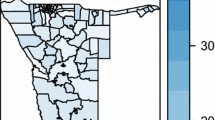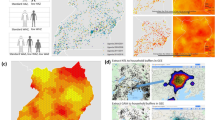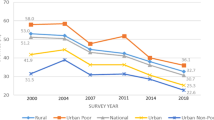Abstract
Limited evidence exists regarding the extent of wealth-related urban inequalities in nutritional outcomes presumably attributable to the rapid pace of urbanisation. The present study has four inter-related objectives. First, it investigates whether there is a difference in the extent of wealth-related urban inequalities between the most rapidly and less rapidly urbanising countries and whether and to what degree parents’ education exacerbates these inequalities. Furthermore, the study examines the nature and strength of the associations between mother’s socio-economic status and child nutrition and between low birth weight and child nutrition in the selected countries. Data are drawn from the recent Demographic and Health Surveys conducted during 2005–2011. The analysis considered inequality measures, such as concentration indices and concentration curves, and logistic regression modelling. Results show significant inequalities in children’s nutritional outcomes, and that these inequalities are greater in the most rapidly urbanising countries and exacerbated by parents’ poor education. The results further confirm that mother’s socio-economic status and child birth weight are significantly associated with child nutritional outcomes, albeit the former are particularly important in the most rapidly urbanising LDCs. The findings call for a renewed focus on inclusive urban development in poorest countries.
Il existe peu d’évidence concernant l’étendue des inégalités nutritionnelles associées à la richesse dans les milieux urbains, vraisemblablement attribuables au taux rapide d’urbanisation. La présente étude comporte quatre objectifs interdépendants. Premièrement, elle cherche à déterminer s'il existe une différence dans l'étendue des inégalités nutritionnelles associées à la richesse dans les milieux urbains entre les pays les plus rapidement et moins rapidement urbanisés, et dans quelle mesure l'éducation des parents accentue ou pas ces inégalités. En outre, l'étude analyse la nature et la force de la relation entre le statut socioéconomique des mères et le faible poids à la naissance et la nutrition des enfants dans les pays sélectionnés. Les données proviennent de récentes enquêtes démographiques et de santé réalisées en 2005-11. L'analyse a examiné des mesures d'inégalité, telles que les indices de concentration et les courbes de concentration, et la modélisation de la régression logistique. Les résultats montrent des inégalités importantes dans les résultats nutritionnels des enfants, que ces inégalités sont plus importantes dans les pays les plus rapidement urbanisés, et qu’elles sont exacerbées par l'éducation médiocre des parents. Les résultats confirment également que le statut socioéconomique de la mère et le poids à la naissance sont significativement associés aux résultats nutritionnels de l'enfant, bien que les premiers soient particulièrement importants dans les pays moins développés plus rapidement en voie d’urbanisation. Les résultats appellent à un recentrage sur le développement urbain inclusif dans les pays les plus pauvres.

Note: As specified in the “ Introduction ”, more rapidly urbanising LDCs include Burkina Faso, Burundi, Mozambique, Nepal and Rwanda, while less rapidly urbanising countries are Congo (DRC), Niger, Senegal, Sierra Leone and Zambia.




Similar content being viewed by others
References
Abuya, B.A., Ciera, J. and Kimani-Murage, E. (2012) Effect of mother’s education on child’s nutritional status in the slums of Nairobi. BMC Pediatrics, 12:80
Adair, L.S., Fall, C.H., Osmond, C., Stein, A.D., Martorell, R., Ramirez-Zea, M., Sachdev, H.S., Dahly, D.L., Bas, I., Norris, S.A., Micklesfield, L., Hallal, P., Victora, C.G. and group, C. (2013) Associations of linear growth and relative weight gain during early life with adult health and human capital in countries of low and middle income: Findings from five birth cohort studies. Lancet, 382, 525–534.
Asian Development Bank (ADB). (2011) Middle of the Pyramid: Dynamics of the Middle Class in Africa. Available: http://www.afdb.org/fileadmin/uploads/afdb/Documents/Publications/The%20Middle%20of%20the%20Pyramid_The%20Middle%20of%20the%20Pyramid.pdf, Accessed 11 October 2016.
Ajieroh V. (2014) A Quantitative Analysis of Determinants of Child and Maternal Malnutrition in Nigeria. Abuja, Nigeria: International Food Policy Research Institute. 2009. e-print. Accessed 3 November 2014.
Arokiasamy, P., Jain, K., Goli, S. and Pradhan, J. (2012) Health inequalities among urban children in India: A comparative assessment of Empowered Action Group (EAG) and South Indian states. Journal of Biosocial Science, 45, 167–185.
Barrios, S., Bertinelli, L. and Strobl, E. (2006) Climatic change and rural–urban migration: The case of sub-Saharan Africa. Journal of Urban Economics, 60, 357–371.
Basta, S.S. (1977) Nutrition and health in low income urban areas of the third world. Ecology of Food and Nutrition, 6, 113–124.
Bloom, D.E., Canning, D. and Fink, G. (2008) Urbanization and the wealth of nations. Science, 319, 772–775.
Annez, P.C. and Buckley, R.M. (2009) Urbanization and Growth: Setting the Context. In: Spence, M. Annez, P. C. and Buckley, R. M. (eds.) Urbanization and Growth. Washington, D.C.: The World Bank
Dabone, C., Delisle, H F. and Receveur, O. (2011) Poor nutritional status of schoolchildren in urban and peri-urban areas of Ouagadougou (Burkina Faso). Nutrition Journal, 10:34
Das, S., Bapat, U., More, N.S., Alcock, G., Fernandez, A. and Osrin, D. (2012) Nutritional status of young children in Mumbai slums: A follow-up anthropometric study. Nutrition Journal, 11, 100.
de Onis, M., Martorell, R., Garza, C., Lartey, A. and Reference, W.M.G. (2006) WHO Child Growth Standards based on length/height, weight and age. Acta Paediatrica, 95, 76–85.
Ekpenyong, A.S. (2015) Urbanization: Its Implication for Sustainable Food Security, Health and Nutritional Nexus in Developing Economies - A Case Study of Nigeria. Journal of Studies in Social Sciences, 11, 29–49.
Fishman, S., Caulfield, L., Onis, M., Hyder, A., Mullany, L., Black, R. and Blossner, M. (2004) Childhood and maternal underweight. In: M. Ezzati, A. D. Lopez, A. Rodgers and C. J. L. Murray (eds.) Comparative quantification of health risks: Global and regional burden of disease attributable to selected major risk factors. Geneva: World Health Organization (WHO).
Fotso, J.C. (2006) Child health inequities in developing countries: Differences across urban and rural areas. International Journal of Equity Health, 5:9.
Fotso, J.C., Madise, N., Baschieri, A., Cleland, J., Zulu, E., Mutua, M.K. and Essendi, H. (2012) Child growth in urban deprived settings: Does household poverty status matter? At which stage of child development? Health and Place, 18, 375–384.
Gold, R., Kawachi, I., Kennedy, B.P., Lynch, J W. and Connell, F.A. (2001) Ecological analysis of teen birth rates: Association with community income and income inequality. Maternal Child Health Journal, 5, 161–167.
Hoffman, D.J. and Lee, S.-K. (2005) The Prevalence of Wasting, but not Stunting, has Improved in the Democratic People’s Republic of Korea. The Journal of Nutrition, 135, 452–456.
Kumar, R., Aggarwal, A.K. and Iyengar, S.D. (1996) Nutritional status of children: Validity of mid-upper arm circumference for screening undernutrition. Indian Pediatr, 33, 189–196.
Lobmayer, P. and Wilkinson, R. (2000). Income, inequality and mortality in 14 developed countries. Sociology of Health & Illness, 22, 401–414.
Mallick, B. and Vogt, J. (2012) Cyclone, coastal society and migration: Empirical evidence from Bangladesh. International Development Planning Review, 34, 217–240.
Marshall, R. and Rahman, S. (2013) Internal Migration in Bangladesh: Character, Drivers and Policy Issues. United Nations Development Programme (UNDP).
Martinez, J., Mboup, G., Sliuzas, R. and Stein, A. (2008) Trends in urban and slum indicators across developing world cities, 1990–2003. Habitat International, 32, 86–108.
Menon, P., Ruel, M.T. and Morris, S.S. (2000) Socio-economic differentials in child stunting are consistently larger in urban than rural areas. Food and Nutrition Bulletin, 21, 282–289.
Michaels, G., Rauch, F. and Redding, S.J. (2012) Urbanization and Structural Transformation. Quarterly Journal of Economics, 127, 535–586.
Montgomery, M.R. and Hewett, P.C. (2005) Urban Poverty and Health in Developing Countries: Household and Neighborhood Effects. Demography, 42(3), 397. doi:10.1353/dem.2005.0020.
Nickanor, N. and Kazembe, N.L. (2016) Increasing Levels of Urban Malnutrition with Rapid Urbanization in Informal Settlements of Katutura, Windhoek: Neighbourhood Differentials and the Effect of Socio-Economic Disadvantage. World Health and Population, 16, 1–17.
O’Donnell, O., van Doorslaer, E., Wagstaff, A. and Lindelow, M. (2008) Analyzing health equity using household survey data: A guide to techniques and their implementation, Washington, D. C., The World Bank.
Ompad, D.C., Galea, S., Caiaffa, W.T. and Vlahov, D. (2007) Social determinants of the health of urban populations: Methodologic considerations. Journal of Urban Health, 84, 42–53.
Reuveny, R. (2007) Climate change-induced migration and violent conflict. Political Geography, 26, 656–673.
Singh, A., Padmadas, S.S., Mishra, U.S., Pallikadavath, S., Johnson, F.A. and Matthews, Z. (2012) Socio-Economic Inequalities in the Use of Postnatal Care in India. PLoS ONE, 7:e37037.
Skop, E. (2006) Introduction – Urban space: The shape of inequality. Urban Geography, 27, 393–396.
Smith, L.C. and Haddad, L. (2000) Explaining Child Malnutrition in Developing Countries: A Cross-Country Analysis. Washington D.C.: International Food Policy Research Institute (IFPRI).
Srinivasan, C.S., Zanello, G. and Shankar, B. (2013) Rural-urban disparities in child nutrition in Bangladesh and Nepal. BMC Public Health, 13, 581.
Svedberg, P. (1990) Undernutrition in Sub‐Saharan Africa: Is there a gender bias? Journal of Development Studies, 26, 469–486.
Szabo, S. (2015) Urbanisation and food insecurity: The role of human development in a post-Malthusian framework, Oxford Development Studies, doi:10.1080/13600818.2015.1067292.
Szabo, S., Renaud, F., Hossain, M.S., Sebesvari, Z., Matthews, Z., Foufoula-Georgiou, E. and Nicholls, R.J. (2015) Sustainable development goals offer new opportunities for tropical delta regions. Environment: Science and Policy for Sustainable Development. 57:16–23
Szabo, S., Nicholls, R., Neumann, B., Renaud, F., Matthews, Z., Sebesvari, Z., AghaKouchak, A., Bales, R., Ruktanonchai, C., Kloos, J., Foufoula-Georgiou, E., Wester, P., New, M., Rhyner, J., Hutton, C., (2016a) “Making SDGs work for climate change hotspots”, Environment: Science and Policy for Sustainable Development, 58(6), 24-33. (doi:10.1080/00139157.2016.1209016)
Szabo, S., Mowlds, S., Claros, M., Kar, A., Di Ciomo, M., and Kashim, I. (2016b) Towards a data users’ framework to advance Sustainable Development Goal 2, International Journal for Population Studies, 2(1), 1–16. doi:10.18063/IJPS.2016.01.008.
Szabo, S. (2016) Urbanisation and inequalities in a post-Malthusian context: Implications for sustainable development. New York: Springer.
UN (1989) UN Convention on the Rights of the Child. Available: http://www.unicef.org.uk/UNICEFs-Work/Our-mission/UN-Convention/ Accessed 22 April 2013.
UN (2014) Open Working Group Proposal for Sustainable Development Goals. Available: https://sustainabledevelopment.un.org/content/documents/1579SDGs%20Proposal.pdf.
UNCTAD (2011) The Least Developed Countries Report 2011. The Potential Role of South-South Cooperation for Inclusive and Sustainable Development. New York and Geneva: United Nations Conference on Trade and Development (UNCTAD).
UNCTAD (2012a) Enabling the Graduation of LDCs: Enhancing the Role of Commodities and Improving Agricultural Productivity. New York and Geneva: United Nations Conference on Trade and Development (UNCTAD).
UNCTAD (2012b) The Least Developed Countries Report 2012. Harnessing Remittances and Diaspora Knowledge to Build Productive Capacities. New York and Geneva: United Nations Conference on Trade and Development (UNCTAD).
UNICEF (2012) The State of the World’s Children 2012. Children in an Urban World. United Nations Children’s Fund (UNICEF).
UNICEF (2013) Childinfo: Monitoring the Situation of Children and Women [Online]. United Nations Children’s Fund (UNICEF). Available: www.childinfo.org/ Accessed 05 August 2013.
United Nations (2016) Provisional Proposed Tiers for Global SDG Indicators, 2016. Available: http://unstats.un.org/sdgs/files/meetings/iaeg-sdgs-meeting-03/Provisional-Proposed-Tiers-for-SDG-Indicators-24-03-16.pdf Accessed 6 December 2016.
Van de Poel, E., O’Donnell, O. and Van Doorslaer, E. (2007) Are urban children really healthier? Evidence from 47 developing countries. Social Science & Medicine, 65, 1986–2003.
Vlahov, D., Freudenberg, N., Proietti, F., Ompad, D., Quinn, A., Nandi, V. and Galea, S. (2007) Urban as a Determinant of Health. Journal of Urban Health, 84, 16–26.
Wagstaff, A. (2000) Socioeconomic inequalities in child mortality: Comparisons across nine developing countries. Bulletin of the World Health Organization, 78, 19-29.
Wamani, H., Nordrehaug Åstrøm, A., Peterson, S., Tumwine, J.K. and Tylleskär, T. (2007) Boys are more stunted than girls in Sub-Saharan Africa: A meta-analysis of 16 demographic and health surveys. BMC Pediatrics, 7.
Warner, K., Hamza, M., Oliver-Smith, A., Renaud, F. and Julca, A. (2010) Climate change, environmental degradation and migration. Natural Hazards, 55, 689-715.
WHO (2008) Our cities, our health, our future. Acting on social determinants for health equity in urban settings. World Health Organization (WHO).
WHO (2010) Nutrition Landscape Information System (NLIS) country profile indicators: Interpretation guide. Geneva: World Health Organization (WHO).
World Bank (2015) The World Development Indicators The World Bank.
Zere, E. and McIntyre, D. (2003) Inequities in under-five child malnutrition in South Africa. Int J Equity Health, 2, 7.
Author information
Authors and Affiliations
Corresponding author
Appendices
Rights and permissions
About this article
Cite this article
Szabo, S., Padmadas, S. & Falkingham, J. Is Rapid Urbanisation Exacerbating Wealth-Related Urban Inequalities in Child Nutritional Status? Evidence from Least Developed Countries. Eur J Dev Res 30, 630–651 (2018). https://doi.org/10.1057/s41287-017-0089-0
Published:
Issue Date:
DOI: https://doi.org/10.1057/s41287-017-0089-0




